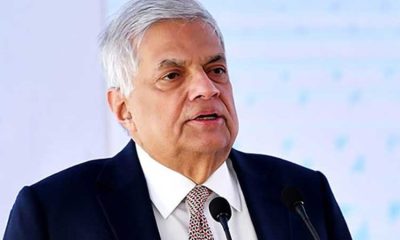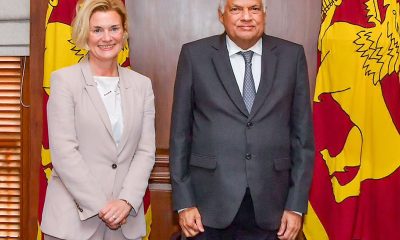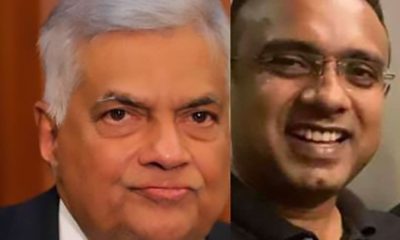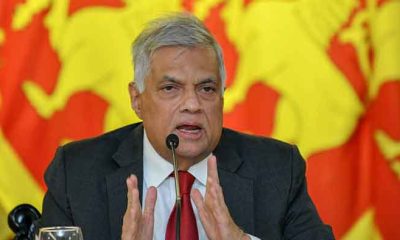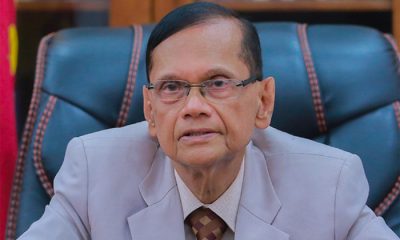Features
Courting Parthasarathy for JRJ, equation changes after Indira’s assassination
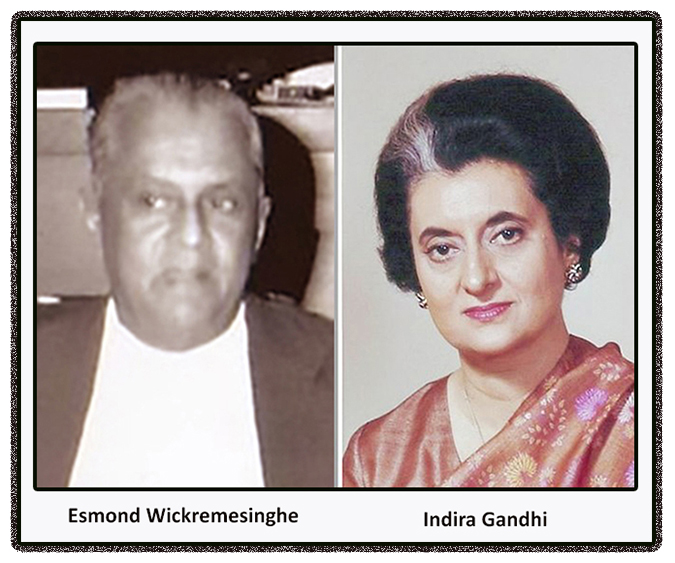
(Excerpted from volume ii of the Sarath Amunugama autobiography)
During one of my visits to Colombo I got a call to see the President at ‘Breamar’. Gamini Dissanayake had told him of my friendship with Parathasarathy and he wanted me to help him repair the damage done to their friendship due to the abuse heaped on GP when he came on a “peace mission” to Colombo.
JRJ had thrown his interlocutor into the ‘deep end’ by arranging a consultation for him with leading monks including Walpola Rahula. The monks had been particularly hard on GP as he was peddling the TULF line. GP was shocked because he had a vision of a peace loving and amiable ‘Sangho.’ that he was used to. Vietnamese Buddhist monks had supported him in his negotiations in Vietnam as Nehru’s envoy.
He had been shocked by this encounter with the monks and tended to think that JRJ had set them up. This was a time when JRJ was disoriented and perturbed by the spectre of 1956 which saw the decimation of the UNP. When I called over the following day at his residence the President was most cordial and inquired about my relations with GP.
He then pulled out a file in which he had gathered information from the time that GP had represented Madras State as a cricketer in the Gopalan Trophy, probably in the 1940s. GP had visited Colombo several times to play against the Ceylon eleven for the trophy. I remember that the news report from the Lake House archives had identified GP as a googly bowler; a good specialty for a future diplomat.
GP had later worked as a journalist in Madras till he moved to New Delhi to join Nehru’s entourage. He was so trusted by India Gandhi that she had appointed him to be the first Chancellor of the Jawaharlal Nehru University [JNU] then being built in the outskirts of Delhi. Since Parthasarathy had left Colombo a disappointed man, JRJ was keen to assure him that the Sri Lanka Government was ready to mend fences and start talking again.
This was a difficult undertaking because the July 1983 riots had severely embarrassed the Indian Government which was being pressurized by the Tamil Nadu politicians and the TULF to intervene. TULF leaders who fled after the riots were housed in Ashok Hotel in New Delhi and were able to get GP to promote their proposals.
Parathasarathy
I collected JRJ’s dossier and flew to New Delhi on my way to Paris GP was most cordial to me and invited me to have breakfast with him at his Lodhi Gardens home. Lodhi Gardens is located in a posh area of the Indian Capital. It housed many of the top officials of the Government. GP’s breakfasts were well known among Indian politicians and bureaucrats because many backroom discussions took place there.
It was a very English breakfast with a butler in atteendance. While breakfasting he assured me that he had no grudge with JRJ though his early goodwill when he accepted the assignment at Indira’s urging had been severely tested. He was agreeable to the idea that I telephone JRJ with that assurance of goodwill. He then pulled a rabbit out of his hat. He wanted me to ioin him on a visit to Ashok Hotel where the Indian Government had housed the leaders of the TULF after they were forced to flee the country following the July riots.
I had no hesitation in joining him as I knew some of these leaders, particularly Sampanthan with whom I had worked in Trincomalee when we demarcated the tourist zones for the Tourist Board. Perhaps GP, being a diplomat, wanted to show me the complex situation confronting Indian decision makers in view of the rapidly changing scenario in Sri Lanka.
Surprisingly the TULF leaders were keen to get back home. Though they were not short of creature comforts in the hotel they were not happy to be virtually incarcerated there without the chance of politicking in the North and East. In their absence the militants were making headway. Since their houses and other possessions in Colombo had been burnt or looted, they were in a state of shock.
Sampanthan told me that what he missed most was his library of books painstakingly collected over a lifetime. His library had been burnt down to the ground. I returned to Paris and telephoned JRJ who was happy that GP had responded that way. He wanted me to keep in touch with my Indian friends so that his position would not be misunderstood.
The Sri Lanka High Commision in New Delhi was not of much use and Hameed the Foreign Minister was asked not to interfere in the negotiations with India. Foreign Secretary Jayasinghe, though a good bureaucrat with strong connections with the Indian immigration officials, made no contribution in helping the President.
This was partly because the President was personally handling foreign policy issues. The lack of coordination in this sphere with a belligerent Lalith Athulathmudali playing a big role through his new Ministry, was beginning to extract its toll Lalith was quickly building up his popularity with the Sinhala voter by adopting a hardline and was being anxiously viewed be Premadasa, Gamini and Ronnie de Mel who could smell a rival when they saw one. The latter two were taking a more conciliatory approach which was welcomed by the Indian authorities.
Esmond’s Testimony
The periodic arrival of Esmond Wickremesinghe to Paris for International Programme for Development Communications (IPDC) meetings helped us to gather more information above the growing ethnic crisis in Sri Lanka. He told us that JRJ did not anticipate that the events of July would spiral out of control as Cyril Mathew had overstepped his brief Esmond said that he had breakfast with the President the day after the Kanatte incident. JRJ had collapsed at the breakfast table thinking that the Sinhala reaction would turn into a huge bloodbath which would be the end of his government.
He was fearful of a violent overthrow of his regime. That was why he prevaricated and did not address the nation immediately and put a stop to the violence. He hesitated and even in his broadcast he seemed to be lukewarm in condemning the Sinhala rioters and offering solace to the Tamils who were terrified and shocked. JRJ was perhaps right in feeling that this marked a watershed in his regime so early in his second term.
Soon after, all the energies of the Government were diverted to resettlement of refugees, funding them and attempting to recalibrate our economic and foreign policies to accommodate a solution to the ethnic problem. K.M. de Silva and Howard Wriggins in their biography of JRJ mark this as a turning point. “From this time to the end of his tenure of office as the Executive President at the end of December 1988. JR had to live with and deal with the consequences that flowed from the riots of 1983”.
As mentioned by writers like Rajiva Wijesinha, this crisis affected the Esmond Wickremesinghe family in different ways. Esmond’s brother Lakshman, who was the Bishop of Kurunegala, was devastated by the violence. He pleaded for reconciliation, but his cry was ignored. He died of a heart attack a few months later. Ranil Wickremesinghe on the other hand did not want to antagonize the Sinhala nationalist voters and tended to side with Mathew who had a strong base in the Kelaniya-Biyagama area.
Esmond while being disturbed by these events evaded the issue by dealing with the technical aspects of the problem on behalf of JRJ. Unlike his brother he was not disturbed by the moral dimension of the fratricidal violence. He felt that he could not abandon his friend at this critical juncture. Like Rajiva Wijesinha I did not see any remorse in Esmond regarding this collective moral failure. In his latest book Rajiva draws an unflattering picture of JRJ in relation to the ethnic and human rights issues.
Esmond briefed us of the Parathsarathy proposals which at that time was hotly opposed by many including the monks like Walpola Rahula and the Mahanayake of Asgiriya, Palipane Chandananda. The Parthasarathy proposals were for the setting up of Provincial Councils in a merged North and East. He was a proponent of devolution of powers within a sovereign state.
When we met the TULF in Ashok Hotel he told the Tamil leaders that he had held the Assamese student leaders incommunicado in Delhi till they agreed to his proposals. This may have put fear in the heads of the TULF leaders who may be forgiven for thinking that they too were being held in Delhi to receive the Assamese treatment. They wanted to get back to Sri Lanka as early as possible.
But as we saw earlier, GP was heavily biased towards the TULF position and its leaders need not have entertained any fears. They were safe with GP. It was only with his departure that a more flexible solution became feasible. His departure was a direct consequence of the death of Indira. Her demise had a direct bearing on JRJ and Sri Lanka’s fortunes.
As the TULF leaders lamented there were “orphaned by her death”. India entered a new phase Of her destiny with the death of Indira or ‘Goddess Durga’ as her numerous enemies called her. It marked a sea change in India’s policy towards Sri Lanka.
Death of Indira
The tragic death of her favourite younger son Sanjay in an air accident affected Indira deeply. He was her choice to succeed her to the `gadi’. But tragedy was to strike the Nehru family again and again. With the death of Sanjay, Indira began to turn to Hinds mystics – particularly to a handsome Sadhu, which association had the gossip prone Delhi on overdrive. She also increasingly became autocratic.
As PM she had to face the growing strength of the Sikhs who had been assiduously wooed and pacified by her father. The Sikh leaders were pampered by Nehru who admired their commitment to the Indian Congress during the Independence movement. The ‘green revolution’ had turned the Punjab into the `granary of India’, which was growing more prosperous by the day.
Also, the out migration of Sikhs to western countries had created pockets of political influence abroad supporting the call for Khalistan – an independent Sikh state. RAW with Indira’s backing was creating local leaders like Bhindranwale, to undercut the troublesome independence seeking Akhali leaders. Standing firm on the Punjab was of the greatest strategic importance for her. As Indira was successful in creating a Bangladesh, could not her enemies, particularly Pakistan, create a Khalistan as tit for tat? In a way the notion of a sovereign Khalistan and Kashmir put a brake on RAW scenarios of an independent Eelam. Eelam could trigger other frightful prospects like a bigger `rogue’ Tamil Nadu outside the Indian Union. Khalistan was a litmus test for the integrity of the Indian Union and Indira unleashed her total strength against the Sikh separatists, led by a RAW invented religious leader Bhindranwale [a la Prabhakaran] who had now turned on his masters.
Indira authorized operation ‘Blue Star’ which was an all-out attack on the extremists holed up in the famous Golden Temple of the Sikhs in Amritsar. It was a murderous, no holds barred attack. The offensive succeeded, the rebels were flushed out and killed, the rebellion was aborted and the majority of Sikhs looked on Indira as a monster who had defiled their holiest site.
The direct result of Operation Blue Star was the assassination of Indira by her Sikh bodyguards when she had left her home on foot to her office a few yards away for a TV interview with BBC. Delhi erupted in an orgy of communal rioting in which thousands of Sikhs were killed and their houses torched. As many studies have shown-including Stanley Tambiah’s ‘Levelling Crowds’ – this was rioting on a mega scale.
It was difficult for Indian diplomats to point their finger at Colombo riots, under these circumstances. The death of Indira meant the end of GP’s leadership of the Sri Lanka negotiations. He was replaced by Romesh Bandari, the Foreign Secretary and personal friend of the new PM. Under Rajiv, who reluctantly succeeded his mother, other players in addition to Bandari entered the scene. They were R Chidambaram, a Harvard trained lawyer from Madurai and N. Ram from the famous Kasturi family – the owners of `The Hindu’.
Ram was a journalist, a Cambridge graduate and a cricketer. In the wings was Venkateshwaran of the Foreign Office who was briefly Foreign Secretary. An admirer of Krishna Menon, Venkateshwaran was a hardliner on the Tamil issue and was sacked summarily by Rajiv Gandhi. The monopoly of Tamilians over Foreign policy was broken. This change of guard brought about a rethinking on India’s Sri Lanka policy.
It was an overall change of direction by Rajiv Gandhi who was moving towards an open economy and dismantling many socialist controls which had fast become dysfunctional during his mother’s ideologically rigid regime. Several of her socialist oriented officials, who were anyway superannuated by now, were shunted aside and a more technology oriented American educated coterie were assembled around the new Prime Minister.
The death of Indira was a blow to the hawks in her entourage who wanted a decisive push against JRJ and the Sri Lankan government. Indira had been looking for a political coup for her Congress party which for the first time since Independence was being challenged by the Janata Party led by former stalwarts of the Congress like Jayaprakash Narayan. She had tried to do something big in the South to bolster her strength and checkmate her political opponents. Her death was therefore a misfortune for the Tamil ‘Ultras’, as Rajiv did not have the same commitment towards them. The LTTE confirmed this set back by planning to assassinate him.
Features
The heart-friendly health minister

by Dr Gotabhya Ranasinghe
Senior Consultant Cardiologist
National Hospital Sri Lanka
When we sought a meeting with Hon Dr. Ramesh Pathirana, Minister of Health, he graciously cleared his busy schedule to accommodate us. Renowned for his attentive listening and deep understanding, Minister Pathirana is dedicated to advancing the health sector. His openness and transparency exemplify the qualities of an exemplary politician and minister.
Dr. Palitha Mahipala, the current Health Secretary, demonstrates both commendable enthusiasm and unwavering support. This combination of attributes makes him a highly compatible colleague for the esteemed Minister of Health.
Our discussion centered on a project that has been in the works for the past 30 years, one that no other minister had managed to advance.
Minister Pathirana, however, recognized the project’s significance and its potential to revolutionize care for heart patients.
The project involves the construction of a state-of-the-art facility at the premises of the National Hospital Colombo. The project’s location within the premises of the National Hospital underscores its importance and relevance to the healthcare infrastructure of the nation.
This facility will include a cardiology building and a tertiary care center, equipped with the latest technology to handle and treat all types of heart-related conditions and surgeries.
Securing funding was a major milestone for this initiative. Minister Pathirana successfully obtained approval for a $40 billion loan from the Asian Development Bank. With the funding in place, the foundation stone is scheduled to be laid in September this year, and construction will begin in January 2025.
This project guarantees a consistent and uninterrupted supply of stents and related medications for heart patients. As a result, patients will have timely access to essential medical supplies during their treatment and recovery. By securing these critical resources, the project aims to enhance patient outcomes, minimize treatment delays, and maintain the highest standards of cardiac care.
Upon its fruition, this monumental building will serve as a beacon of hope and healing, symbolizing the unwavering dedication to improving patient outcomes and fostering a healthier society.We anticipate a future marked by significant progress and positive outcomes in Sri Lanka’s cardiovascular treatment landscape within the foreseeable timeframe.
Features
A LOVING TRIBUTE TO JESUIT FR. ALOYSIUS PIERIS ON HIS 90th BIRTHDAY

by Fr. Emmanuel Fernando, OMI
Jesuit Fr. Aloysius Pieris (affectionately called Fr. Aloy) celebrated his 90th birthday on April 9, 2024 and I, as the editor of our Oblate Journal, THE MISSIONARY OBLATE had gone to press by that time. Immediately I decided to publish an article, appreciating the untiring selfless services he continues to offer for inter-Faith dialogue, the renewal of the Catholic Church, his concern for the poor and the suffering Sri Lankan masses and to me, the present writer.
It was in 1988, when I was appointed Director of the Oblate Scholastics at Ampitiya by the then Oblate Provincial Fr. Anselm Silva, that I came to know Fr. Aloy more closely. Knowing well his expertise in matters spiritual, theological, Indological and pastoral, and with the collaborative spirit of my companion-formators, our Oblate Scholastics were sent to Tulana, the Research and Encounter Centre, Kelaniya, of which he is the Founder-Director, for ‘exposure-programmes’ on matters spiritual, biblical, theological and pastoral. Some of these dimensions according to my view and that of my companion-formators, were not available at the National Seminary, Ampitiya.
Ever since that time, our Oblate formators/ accompaniers at the Oblate Scholasticate, Ampitiya , have continued to send our Oblate Scholastics to Tulana Centre for deepening their insights and convictions regarding matters needed to serve the people in today’s context. Fr. Aloy also had tried very enthusiastically with the Oblate team headed by Frs. Oswald Firth and Clement Waidyasekara to begin a Theologate, directed by the Religious Congregations in Sri Lanka, for the contextual formation/ accompaniment of their members. It should very well be a desired goal of the Leaders / Provincials of the Religious Congregations.
Besides being a formator/accompanier at the Oblate Scholasticate, I was entrusted also with the task of editing and publishing our Oblate journal, ‘The Missionary Oblate’. To maintain the quality of the journal I continue to depend on Fr. Aloy for his thought-provoking and stimulating articles on Biblical Spirituality, Biblical Theology and Ecclesiology. I am very grateful to him for his generous assistance. Of late, his writings on renewal of the Church, initiated by Pope St. John XX111 and continued by Pope Francis through the Synodal path, published in our Oblate journal, enable our readers to focus their attention also on the needed renewal in the Catholic Church in Sri Lanka. Fr. Aloy appreciated very much the Synodal path adopted by the Jesuit Pope Francis for the renewal of the Church, rooted very much on prayerful discernment. In my Religious and presbyteral life, Fr.Aloy continues to be my spiritual animator / guide and ongoing formator / acccompanier.
Fr. Aloysius Pieris, BA Hons (Lond), LPh (SHC, India), STL (PFT, Naples), PhD (SLU/VC), ThD (Tilburg), D.Ltt (KU), has been one of the eminent Asian theologians well recognized internationally and one who has lectured and held visiting chairs in many universities both in the West and in the East. Many members of Religious Congregations from Asian countries have benefited from his lectures and guidance in the East Asian Pastoral Institute (EAPI) in Manila, Philippines. He had been a Theologian consulted by the Federation of Asian Bishops’ Conferences for many years. During his professorship at the Gregorian University in Rome, he was called to be a member of a special group of advisers on other religions consulted by Pope Paul VI.
Fr. Aloy is the author of more than 30 books and well over 500 Research Papers. Some of his books and articles have been translated and published in several countries. Among those books, one can find the following: 1) The Genesis of an Asian Theology of Liberation (An Autobiographical Excursus on the Art of Theologising in Asia, 2) An Asian Theology of Liberation, 3) Providential Timeliness of Vatican 11 (a long-overdue halt to a scandalous millennium, 4) Give Vatican 11 a chance, 5) Leadership in the Church, 6) Relishing our faith in working for justice (Themes for study and discussion), 7) A Message meant mainly, not exclusively for Jesuits (Background information necessary for helping Francis renew the Church), 8) Lent in Lanka (Reflections and Resolutions, 9) Love meets wisdom (A Christian Experience of Buddhism, 10) Fire and Water 11) God’s Reign for God’s poor, 12) Our Unhiddden Agenda (How we Jesuits work, pray and form our men). He is also the Editor of two journals, Vagdevi, Journal of Religious Reflection and Dialogue, New Series.
Fr. Aloy has a BA in Pali and Sanskrit from the University of London and a Ph.D in Buddhist Philosophy from the University of Sri Lankan, Vidyodaya Campus. On Nov. 23, 2019, he was awarded the prestigious honorary Doctorate of Literature (D.Litt) by the Chancellor of the University of Kelaniya, the Most Venerable Welamitiyawe Dharmakirthi Sri Kusala Dhamma Thera.
Fr. Aloy continues to be a promoter of Gospel values and virtues. Justice as a constitutive dimension of love and social concern for the downtrodden masses are very much noted in his life and work. He had very much appreciated the commitment of the late Fr. Joseph (Joe) Fernando, the National Director of the Social and Economic Centre (SEDEC) for the poor.
In Sri Lanka, a few religious Congregations – the Good Shepherd Sisters, the Christian Brothers, the Marist Brothers and the Oblates – have invited him to animate their members especially during their Provincial Congresses, Chapters and International Conferences. The mainline Christian Churches also have sought his advice and followed his seminars. I, for one, regret very much, that the Sri Lankan authorities of the Catholic Church –today’s Hierarchy—- have not sought Fr.
Aloy’s expertise for the renewal of the Catholic Church in Sri Lanka and thus have not benefited from the immense store of wisdom and insight that he can offer to our local Church while the Sri Lankan bishops who governed the Catholic church in the immediate aftermath of the Second Vatican Council (Edmund Fernando OMI, Anthony de Saram, Leo Nanayakkara OSB, Frank Marcus Fernando, Paul Perera,) visited him and consulted him on many matters. Among the Tamil Bishops, Bishop Rayappu Joseph was keeping close contact with him and Bishop J. Deogupillai hosted him and his team visiting him after the horrible Black July massacre of Tamils.
Features
A fairy tale, success or debacle

Sri Lanka-Singapore Free Trade Agreement
By Gomi Senadhira
senadhiragomi@gmail.com
“You might tell fairy tales, but the progress of a country cannot be achieved through such narratives. A country cannot be developed by making false promises. The country moved backward because of the electoral promises made by political parties throughout time. We have witnessed that the ultimate result of this is the country becoming bankrupt. Unfortunately, many segments of the population have not come to realize this yet.” – President Ranil Wickremesinghe, 2024 Budget speech
Any Sri Lankan would agree with the above words of President Wickremesinghe on the false promises our politicians and officials make and the fairy tales they narrate which bankrupted this country. So, to understand this, let’s look at one such fairy tale with lots of false promises; Ranil Wickremesinghe’s greatest achievement in the area of international trade and investment promotion during the Yahapalana period, Sri Lanka-Singapore Free Trade Agreement (SLSFTA).
It is appropriate and timely to do it now as Finance Minister Wickremesinghe has just presented to parliament a bill on the National Policy on Economic Transformation which includes the establishment of an Office for International Trade and the Sri Lanka Institute of Economics and International Trade.
Was SLSFTA a “Cleverly negotiated Free Trade Agreement” as stated by the (former) Minister of Development Strategies and International Trade Malik Samarawickrama during the Parliamentary Debate on the SLSFTA in July 2018, or a colossal blunder covered up with lies, false promises, and fairy tales? After SLSFTA was signed there were a number of fairy tales published on this agreement by the Ministry of Development Strategies and International, Institute of Policy Studies, and others.
However, for this article, I would like to limit my comments to the speech by Minister Samarawickrama during the Parliamentary Debate, and the two most important areas in the agreement which were covered up with lies, fairy tales, and false promises, namely: revenue loss for Sri Lanka and Investment from Singapore. On the other important area, “Waste products dumping” I do not want to comment here as I have written extensively on the issue.
1. The revenue loss
During the Parliamentary Debate in July 2018, Minister Samarawickrama stated “…. let me reiterate that this FTA with Singapore has been very cleverly negotiated by us…. The liberalisation programme under this FTA has been carefully designed to have the least impact on domestic industry and revenue collection. We have included all revenue sensitive items in the negative list of items which will not be subject to removal of tariff. Therefore, 97.8% revenue from Customs duty is protected. Our tariff liberalisation will take place over a period of 12-15 years! In fact, the revenue earned through tariffs on goods imported from Singapore last year was Rs. 35 billion.
The revenue loss for over the next 15 years due to the FTA is only Rs. 733 million– which when annualised, on average, is just Rs. 51 million. That is just 0.14% per year! So anyone who claims the Singapore FTA causes revenue loss to the Government cannot do basic arithmetic! Mr. Speaker, in conclusion, I call on my fellow members of this House – don’t mislead the public with baseless criticism that is not grounded in facts. Don’t look at petty politics and use these issues for your own political survival.”
I was surprised to read the minister’s speech because an article published in January 2018 in “The Straits Times“, based on information released by the Singaporean Negotiators stated, “…. With the FTA, tariff savings for Singapore exports are estimated to hit $10 million annually“.
As the annual tariff savings (that is the revenue loss for Sri Lanka) calculated by the Singaporean Negotiators, Singaporean $ 10 million (Sri Lankan rupees 1,200 million in 2018) was way above the rupees’ 733 million revenue loss for 15 years estimated by the Sri Lankan negotiators, it was clear to any observer that one of the parties to the agreement had not done the basic arithmetic!
Six years later, according to a report published by “The Morning” newspaper, speaking at the Committee on Public Finance (COPF) on 7th May 2024, Mr Samarawickrama’s chief trade negotiator K.J. Weerasinghehad had admitted “…. that forecasted revenue loss for the Government of Sri Lanka through the Singapore FTA is Rs. 450 million in 2023 and Rs. 1.3 billion in 2024.”
If these numbers are correct, as tariff liberalisation under the SLSFTA has just started, we will pass Rs 2 billion very soon. Then, the question is how Sri Lanka’s trade negotiators made such a colossal blunder. Didn’t they do their basic arithmetic? If they didn’t know how to do basic arithmetic they should have at least done their basic readings. For example, the headline of the article published in The Straits Times in January 2018 was “Singapore, Sri Lanka sign FTA, annual savings of $10m expected”.
Anyway, as Sri Lanka’s chief negotiator reiterated at the COPF meeting that “…. since 99% of the tariffs in Singapore have zero rates of duty, Sri Lanka has agreed on 80% tariff liberalisation over a period of 15 years while expecting Singapore investments to address the imbalance in trade,” let’s turn towards investment.
Investment from Singapore
In July 2018, speaking during the Parliamentary Debate on the FTA this is what Minister Malik Samarawickrama stated on investment from Singapore, “Already, thanks to this FTA, in just the past two-and-a-half months since the agreement came into effect we have received a proposal from Singapore for investment amounting to $ 14.8 billion in an oil refinery for export of petroleum products. In addition, we have proposals for a steel manufacturing plant for exports ($ 1 billion investment), flour milling plant ($ 50 million), sugar refinery ($ 200 million). This adds up to more than $ 16.05 billion in the pipeline on these projects alone.
And all of these projects will create thousands of more jobs for our people. In principle approval has already been granted by the BOI and the investors are awaiting the release of land the environmental approvals to commence the project.
I request the Opposition and those with vested interests to change their narrow-minded thinking and join us to develop our country. We must always look at what is best for the whole community, not just the few who may oppose. We owe it to our people to courageously take decisions that will change their lives for the better.”
According to the media report I quoted earlier, speaking at the Committee on Public Finance (COPF) Chief Negotiator Weerasinghe has admitted that Sri Lanka was not happy with overall Singapore investments that have come in the past few years in return for the trade liberalisation under the Singapore-Sri Lanka Free Trade Agreement. He has added that between 2021 and 2023 the total investment from Singapore had been around $162 million!
What happened to those projects worth $16 billion negotiated, thanks to the SLSFTA, in just the two-and-a-half months after the agreement came into effect and approved by the BOI? I do not know about the steel manufacturing plant for exports ($ 1 billion investment), flour milling plant ($ 50 million) and sugar refinery ($ 200 million).
However, story of the multibillion-dollar investment in the Petroleum Refinery unfolded in a manner that would qualify it as the best fairy tale with false promises presented by our politicians and the officials, prior to 2019 elections.
Though many Sri Lankans got to know, through the media which repeatedly highlighted a plethora of issues surrounding the project and the questionable credentials of the Singaporean investor, the construction work on the Mirrijiwela Oil Refinery along with the cement factory began on the24th of March 2019 with a bang and Minister Ranil Wickremesinghe and his ministers along with the foreign and local dignitaries laid the foundation stones.
That was few months before the 2019 Presidential elections. Inaugurating the construction work Prime Minister Ranil Wickremesinghe said the projects will create thousands of job opportunities in the area and surrounding districts.
The oil refinery, which was to be built over 200 acres of land, with the capacity to refine 200,000 barrels of crude oil per day, was to generate US$7 billion of exports and create 1,500 direct and 3,000 indirect jobs. The construction of the refinery was to be completed in 44 months. Four years later, in August 2023 the Cabinet of Ministers approved the proposal presented by President Ranil Wickremesinghe to cancel the agreement with the investors of the refinery as the project has not been implemented! Can they explain to the country how much money was wasted to produce that fairy tale?
It is obvious that the President, ministers, and officials had made huge blunders and had deliberately misled the public and the parliament on the revenue loss and potential investment from SLSFTA with fairy tales and false promises.
As the president himself said, a country cannot be developed by making false promises or with fairy tales and these false promises and fairy tales had bankrupted the country. “Unfortunately, many segments of the population have not come to realize this yet”.
(The writer, a specialist and an activist on trade and development issues . )


